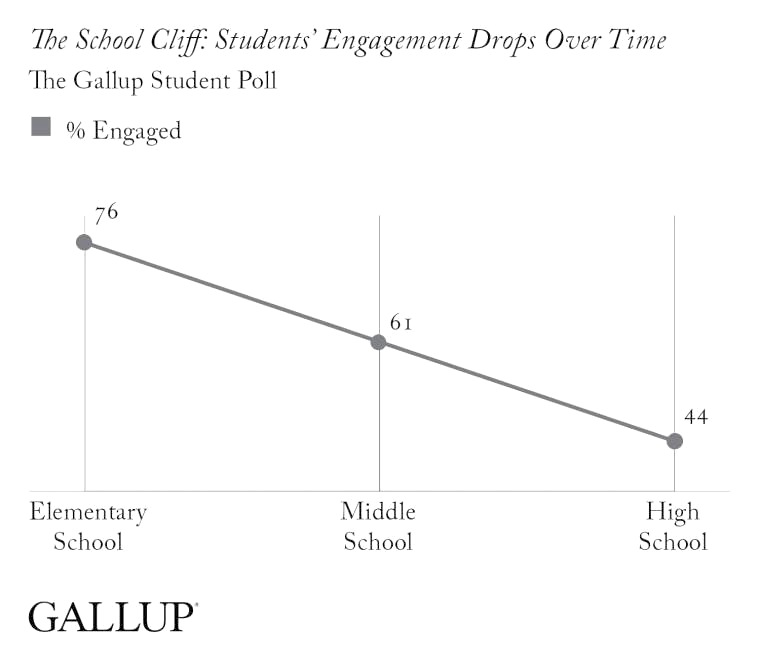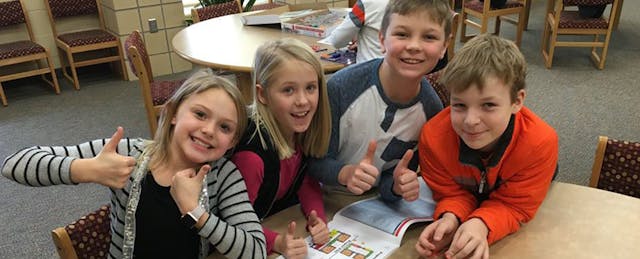Public schools play a huge role in developing learners to be successful when they leave school. So why are charters and private schools considered the best places for “personalized learning”?
The problem with the current public education model is that it was created for the industrial revolution. In fact, U.S. Secretary of Education Arne Duncan said that the K-12 system “largely still adheres to the century-old, industrial-age factory model of education.” Essentially, students come to school at the elementary level excited about learning—but become disengaged by the time they get to high school, as evidenced by the graph to the right.

Think about this familiar situation, for a second: Student A is in 2nd grade and struggles with reading. Students are not finding their passions, and instead sitting in classes consuming information. The end of the year comes, and the student is ready for 3rd grade in math—but not 3rd grade reading. Do you see where frustration starts to kick in?
To combat this issue, Harrisburg, South Dakota is taking concrete steps to go from teacher-driven to student driven learning. How? First by eliminating grade levels, and then by bringing in a flexible collection of learning environments. Here’s our 2016-2017 recipe for success.
Deciding on the “Flavor” of Learning
At Harrisburg Freedom Elementary, we have big plans for our personalized learning model rolling out the fall of 2016. Essentially, our personalized learning program will be move from teacher-centered to learner-centered classrooms by supporting the following:
- More active learning, so that learners are not merely more active through creating, deciding, and so on, but are also more actively learning through the positive review of their experience and the meaning-making this involves.
- More collaborative learning, so that learners come to see themselves and others as resources in meaning-making, rather than the teacher being the sole fount of knowledge
- More learner-driven learning, so that learners come to drive the agenda as they generate questions, organize inquiry and evaluate their products and progress.
And here’s the big kicker: we have decided to eliminate grades for our learners.
Assembling Ingredients
This personalized-learning track, designed for 94 students in grades 2-5, is moving away from the 2nd grade classroom, 3rd classroom, and so on. Instead of being confined to grade-level classes, students will move in “studios.” Studios will be aligned to grade level standards determined by four teachers (identified as “studio coaches”), but the students won’t know if they are moving up or down. In fact, there are no numbers involved; each studio will be a letter of our program, called EPIC (Empowering, Personalizing, Innovating, Creating).
Each day will start with a morning meeting to explain the offerings for the day, followed by a healthy dose of student choice. How so? Students select which studio activity they’d like to use—each and every single day. This will give the learners voice and choice in what area do they need to be in to work on the different assignments, without confining them to grade level-specific activities.
Here are a sample of learning environments that have been created by Pioneer Ridge Middle School’s Adventures program where students decide what is best for their learning. These environments will function similarly in our EPIC program to help meet the needs our learners.
| Studio Activities | Description | How it supports the learning process |
|---|---|---|
| DAILY DISH | Daily meeting for learners and teachers to create a learning plan | Learners prepare for the day. They will receive instructions on things happening in each of the studios along with any changes. This will also be a goal-setting time for learners. |
| SEMINAR | Teacher-led instruction | New learning targets are being taught through direct instruction. |
| COACHING WORKSHOP | Small group instruction on specific learning | After a learning target has been taught, learners still may need some support. They can sign up for a coaching workshop to get more attention. |
| CONFERENCES | One-to-one meetings with a teacher to support specific learning | These meetings will happen throughout the week to check in with learners and make sure they have the needed resources to continue moving on their learning journey. |
| CT CIRCLES | Critical thinking discussion groups to help learners deepen their understanding of specific learning | These circles will be used in reading and writing. Learners will have time to ask questions about their reading and work on learning targets to achieve mastery. |
| GROUP FLEX | Collaborative learning time | This is for group projects, where learners use the group flex area to collaborate, brainstorm, and develop a product. |
| PERSONAL FLEX | Self-selected, individualized learning time | Some learners learn best by watching a flipped video or working alone, so instead of attending a seminar, the learner is watching a video in the personal flex area of the room. |
| LAB | Investigative opportunities | This is where the “creation” part happens. Learners will use this area to create and show mastery. |
Prepping the Recipe
With the ingredients in tow, here’s a window inside our recipe, as seen through the experience of a group of learners tackling “reading and writing”:
- Student will arrive to school and head to their “studio” for the Daily Dish. This will be where they get any announcements for the day.
- After the Daily Dish, when students head into Reading and Writing, they can select a studio activity from the chart above. Learners will have “must do’s” to complete, but once they are ready to show mastery, they will be able to show it however they choose.
- At the end of Reading and Writing time, learners reflect on what they did well today, and what they need support on tomorrow. This feedback to the teacher is vital to provide what the learners need the next day.
Non-Negotiables to Remember
If we do not set standard operating procedures with our learners from the start, this is going to be hard to manage. It is important that we have a system that will not only show growth, but communicate that growth with the parents on a weekly basis. So, we’ve assembled a list of three non-negotiables that will always be in place:
- SOPs (Standard Operating Procedures)
- Use of a communication tool (i.e. ClassDojo or Remind) to alert parents on their learners’ progress
- Time—specifically for teachers to collaborate and review learner needs from the day before
And there are few other non-negotiables we need: trust and hard work, with teachers combining their philosophies to reach all the learners. This won’t be easy, but at the end of the day, we know it’s worth it. Instead of students being bored in school, we hope t have them running to the teacher because they are so excited for what’s next.
We’ll see you in a year—to let you know how things are going.


